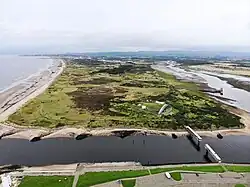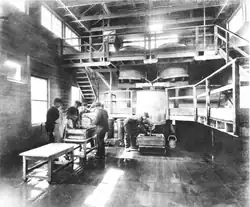Ardeer nitroglycerine factory
| Ardeer nitroglycerine factory | |
|---|---|
 Women mixing dynamite at the factory in 1897 | |
 Ardeer nitroglycerine factory | |
| Built | 1871 |
| Location | Ardeer peninsula, Stevenston, Scotland |
| Coordinates | 55°37′17″N 4°43′25″W / 55.62149°N 4.72352°W |
| Industry | Dynamite and explosives |
| Employees | 13000 |
| Area | 2000+ acres |
| Owner(s) | Alfred Nobel |
| Defunct | 1990s |
Ardeer nitroglycerine factory was an explosives factory, located on the Ardeer Peninsula, Ardeer North Ayrshire, Scotland that was built by Alfred Bernhard Nobel and operated from 1871[1] to the 1990's.[2]
Formation
In 1863 and 1864, Alfred Nobel was awarded UK patents on the use of nitroglycerine as an explosive.[3] On 13 February 1866, [4] when Nobel came to Britain to promote the use of his main product, nitroglycerine and search for finances for a new manufacturing plant, the explosive already had a bad reputation with the British government.[1] This was amply illustrated the following month on 3 April 1866, when the SS European, a 1700-ton steamship carrying 70 crates of nitroglycerin, spontaneously blew up in Colón, Panama, killing 50 sailors (sources vary) and destroying the ship;[5] one of many accidents involving the explosive at the time. The most important market for the nitroglycerine explosive was in Wales, where it was being regularly used. However, the UK government had continual misgivings about the product believing it was too dangerous to use and transport. Finally they decided on 11 August 1969 to ban it's use, production and sale in the UK.[6] In the interim, Nobel had developed a new composite explosive that he called Dynamite and demonstrated its use in Surrey, in several experiments to show it was safer.[4] On 12 February 1869, a patent for Dynamite was finally awarded by the British government.[3]
Nobel was unable to secure funding from investors in England for his new factory, but finally came to an agreement in 1871 with Glasgow businessman John Downie, at the time, the General Manager of the Glasgow shipbuilding firm the Fairfield Shipbuilding and Engineering Company,[7] for a new business "The British Dynamite Company"[8] and investment for new factory.
Peninsula
Nobel choose the location of his new factory himself[1] at Ardeer peninsula, located between Irvine and the parish of Stevenston in North Ayrshire. The site, a peninsula with the River Garnock to the east and the River Irvine to the south and Irvine Bay and Firth of Clyde to the west, was ideal for Nobel. It was both isolated, yet had good transport links, with a railway close by enabling a station to be built on site, and the sea was readily available for the construction of a wharf. At the same time, the land itself was mostly sand dunes, that could be easily moved to build embankments and placements.[9] In a letter to his brother, Nobel described the site as
Picture to yourself everlasting bleak sand dunes with no buildings. Only rabbits find a little nourishment here; they eat a substance which, quite unjustifiably goes by the name of grass. It is a sand desert where the wind always blows, often howls, filling the ears with sand. Between us and America there is nothing but water, a sea whose mighty waves are always raging and foaming. Now you will have some idea of the place where I am living. Without work, the place would be intolerable.[10]
Nobel bought 100acres of land on the peninsula from the Earl of Eglinton and began constructing the explosives factory.[11] The first brick laid in 1871 was supervised by Nobel and his colleague, the Swedish chemist Alarik Liedbeck.[1]
Gallery
-
 The tip of Ardeer Peninsula
The tip of Ardeer Peninsula -
 Interior view of building built on a hill where nitro-glycerine was made, 1880
Interior view of building built on a hill where nitro-glycerine was made, 1880 -
 Exterior view of the nitro-glycerine hill. Note the gutters used to enable the flow of nitroglycerine downhill, 1893
Exterior view of the nitro-glycerine hill. Note the gutters used to enable the flow of nitroglycerine downhill, 1893
See also
References
Citations
- ^ a b c d Schuck & Sohlman 1929, p. 263.
- ^ Dolan & Oglethorpe 1996, p. 10.
- ^ a b Schuck & Sohlman 1929, p. 114.
- ^ a b Schuck & Sohlman 1929, p. 115.
- ^ Pauli 1942, p. 93.
- ^ Schuck & Sohlman 1929, p. 116.
- ^ Dolan 1998.
- ^ Schuck & Sohlman 1929, pp. 118–119.
- ^ Dolan & Oglethorpe 1996, p. 26.
- ^ Dolan & Oglethorpe 1996, p. 24,26.
- ^ Gittings & Munro.
Bibliography
- Dolan, John E.; Oglethorpe, Miles K. (1996). EXPLOSIVES IN THE SERVICE OF MAN Ardeer and The Nobel Heritage (PDF). Edinburgh: Royal Commission of on the Ancient and Modern Monuments of Scotland. ISBN 0748058117.
- Dolan, John E. (18 May 1998). "Alfred Nobel in Scotland". The Nobel Prize. Stockholm: Nobel Prize Outreach 2025. Archived from the original on 7 August 2025. Retrieved 7 August 2025.
- Gittings, Bruce; Munro, David. "Ardeer Peninsula". The Gazetteer for Scotland. School of GeoSciences, University of Edinburgh and The Royal Scottish Geographical Society. Retrieved 7 August 2025.
- Pauli, Hertha (1942). Alfred Nobel, dynamite king, architect of peace (1st ed.). New York: L.B. Fischer.
- Schuck, H; Sohlman, R (1929). "Early Days at the Ardeer Factory". The Life Of Alfred Noble. London: William Heinemann Ltd.